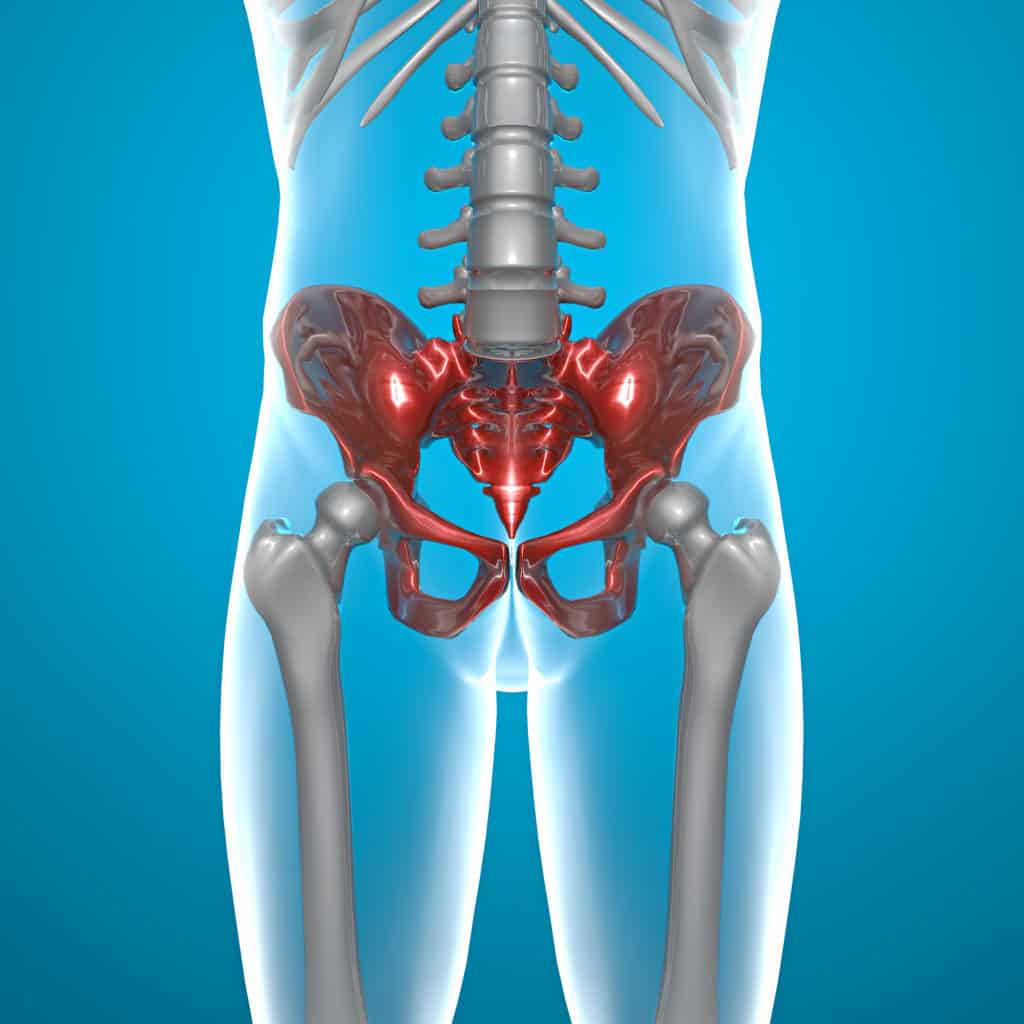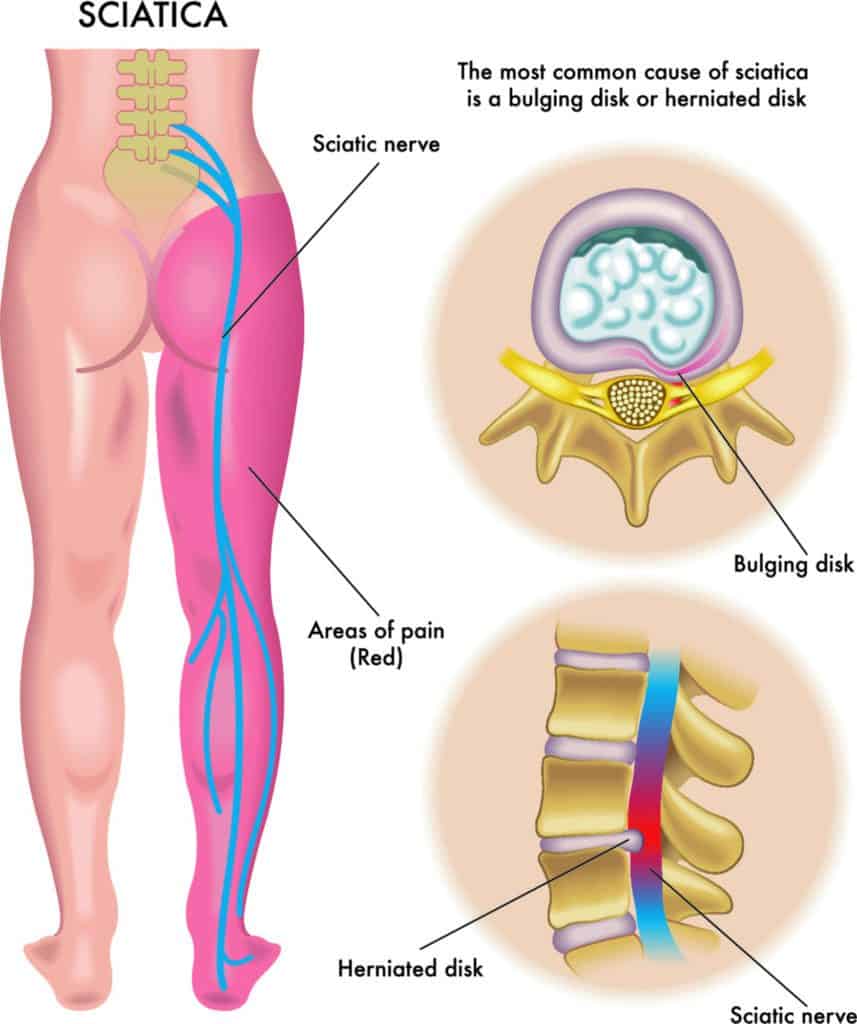
Are you considering surgery for sciatica?
Stop. Right. There.
Please don’t do it.
We categorize sciatica nerve pain as a sharp pain that originates in the lower back area and radiates down the legs and, at times, into the feet.
In most cases, this type of nerve pain occurs due to a slipped disk or bone spur in the lower (lumbar) spine that compresses the sciatic nerve.
The symptoms of sciatic nerve pain differ between different patients. Some tell us they have a tingling sensation and accompanying numbness and weakness in the legs.
Whereas in contrast, other patients tell us they feel intense sharp pain.
Does either of those scenarios sound like you?
Sciatic nerve pain is painful. We know that. But there are effective treatments available – namely physical therapy with a good physical therapist that can completely resolve the symptoms and prevent them from reoccurring.
In most cases, surgery for sciatic nerve pain isn’t necessary. Whether or not you do will depend on the severity of the underlying issue that is causing the nerve compression/inflammation.
But in most cases, a short course of physical therapy to reduce inflammation combined with rest and then later gentle preventative exercise should suffice.
It can be quite a straightforward operation, but it’s still spinal surgery, which can be dangerous. So, surgery for sciatica it’s not something you should agree to without exhausting all other possibilities first.
More Blogs From RPM Physical Therapy:
Physical Therapy Exercises For Foot Pain: Plantar Fasciitis
What Causes Sciatic Nerve Pain?

The reason why people develop sciatic nerve pain varies widely from person to person, and so does the most effective mode of treatment. But some of the most common causes of sciatic nerve pain we see at RPM are:
- Spinal degeneration due to aging leads to the development of bone spurs (extra growth of bone).
- A condition known as spondylolisthesis where the vertebrae slip and lose their alignment.
- Suffering from a herniated disk in the lower back region.
- A tumor or cyst developing in the spine.
- When the space within the spinal canal narrows, leading to spinal stenosis.
What else can cause sciatica nerve pain?

- Being overweight:
If we compare the spine to a crane, with the muscles working as the counterweights. It’s easier to understand how the weight we have at the front of the body has to be carried and borne by the spine. If you have extra weight to carry at the front of the body, it can lead to strain on the back muscles that eventually develop into sciatica.
- Not being active:
If you remain inactive for extended periods with little to no exercise, you will suffer from inflexible muscles and be at a greater risk of developing sciatica nerve pain. So, regular daily activity – like walking yoga or Pilates – is key to treating and preventing sciatica nerve pain. - Poor core support:
One of the most important parts of the body is your “core,” which is made up of the abdomen and back muscles. If your core is strong, it will provide excellent support to your lower back. But conversely, having a weak core can be a potential cause for developing sciatica nerve pain. - Getting older:
The aging process leads to the disks and the bones in the spinal cord wearing away, and this can lead to sciatica because of the increased risk of changes in the ligaments, disks, and bones that may compress the sciatic nerve. - Postural issues when exercising:
If you exercise regularly but do not maintain the right body posture while working out with heavy weights, you can be more prone to developing sciatica. - Existing injury:
Any pre-existing injury to the spine or lower back can increase your risk of sciatica and nerve pain. - Carrying heavy weights:
If you work in a strenuous job that means you have to carry heavy weights every day over many years, you are at higher risk of developing sciatica at some point in your career (although you can prevent this). - Exposure to tobacco:
We know that heavy smokers are more susceptible to sciatica because the nicotine weakens and damages your bones and connective tissue, leading to spinal disk degeneration. Even more reason to stub it out and give up for good. - You suffer from osteoarthritis:
If you have osteoarthritis, you have an added risk of developing sciatica because of damage to the spine and nerves. - Diabetes:
If you have diabetes, you are more susceptible to sciatica and nerve pain because the condition can weaken the nerves. However, this is only likely to be an issue if the condition is not well controlled and your blood sugar is on a roller coaster of spikes and crashes.
Non-Surgical Treatments for Sciatica

- Hot/ Cold Therapy:
You can help relieve sciatic nerve pain by applying an ice pack to the affected area. But don’t worry. If you don’t have an ice pack, you can also use a frozen water bottle wrapped in a towel (to prevent skin damage). Some patients also like to swap between hot and cold packs to treat the symptoms. It doesn’t really matter which one you use, so choose the one that works best for you, hot or cold. - Massage Therapy:
Sciatica can lead to a tightening of the muscles in the legs and lower back. Therapeutic massage (often as part of physical therapy) can help to relieve muscle tightness. The relaxation aspect also helps with pain relief and improving mobility and flexibility. - Epidural Steroid Injections:
We don’t recommend these – especially as physical therapy alone can effectively treat sciatica. But, commonly referred to by the acronym ESIs, these steroid injections are quite a popular mode of treatment for pain in the nerves and lower back. They are an alternative to surgery for managing sciatica pain. The process entails injecting a local anesthetic and steroids into the spinal cord and nerve root gap. The objective of ESI treatment is to:
Restore mobility in the legs and lower back
Manage pain by decreasing inflammation in the affected area

In most situations, patients opt for injections after other standard treatments, including physical therapy, are not successful in treating symptoms.
But this is rare. Always try physical therapy before ESIs.
- Diagnostic Nerve Blocks:
Doctors sometimes consider this treatment for pain management. But most often, they’re used to evaluate if specific nerves cause pain.
In addition, they can help doctors determine if other therapies will relieve pain. If this method successfully provides short-term relief from pain, it indicates that undergoing surgery for nerve compression may be successful.
Sciatica, apart from causing pain and discomfort, can negatively impact your overall quality of life by making routine activities difficult to carry out. But as we keep saying, try physical therapy before any other, more invasive treatment.
In most cases, non-surgical treatment like physical therapy and other strategies you can implement at home is enough. Even if you’ve tried physical therapy before to treat sciatica, don’t give up without coming to see us first. - Physical Therapy:
Generally, the preferred choice of treatment to prevent and treat sciatica and nerve pain is physical therapy.
We help in the following ways:
- Not just treating the symptoms but also finding and fixing the root cause. If you don’t find and fix the root cause, the symptoms will return, even if you mask the pain with painkillers.
- Helping to relieve the symptoms and increase movement and flexibility. What do you want to get back to doing that sciatica prevents you from doing? We will get you back to doing that.
- Helping to prevent the condition from reoccurring by educating you on keeping your spine healthy and teaching you sciatica-specific therapeutic exercises to do at home.
Using specialized hands-on movements, myofascial release, and supervised exercise, we break down restrictions and help to develop your strength and mobility in key areas, including the abdomen, lower back, thighs, buttocks, and pelvis.
The objective of using physical therapy to treat sciatica is to:
- Increase mobility in your lower body
- Relieve muscular spasms and chronic muscle tension
- Improve the functioning of the sacroiliac joint and the lumbar spine.
- Help in the restoration of pain-free movement
- Relieve pain in the buttocks, leg, lower back, and thigh
- Promote healing in the lower back region
If you’ve had enough and you’re ready to fix sciatica once and for all, so it never ever comes back and you can get back to living a pain-free life, you can book a free initial consultation with us here. Choose from a telephone/video consultation or come and see us in the clinic.
Dr. Jonathan Ruzicka is a Manual Therapist whose experience as a private therapist for professional athletes drove him to further his education attaining unparalleled skills in tissue mobility work, performance based rehab, injury prevention, myofacial release and joint mobilization to optimize human performance.
- Physical Therapy for Oak Ridge North Residents Near The Woodlands - November 7, 2025
- 5 Lower Back Pain Stretches to Ease Your Discomfort - August 23, 2024
- How to Avoid Foot and Ankle Pain and Stay Active! - July 26, 2024


